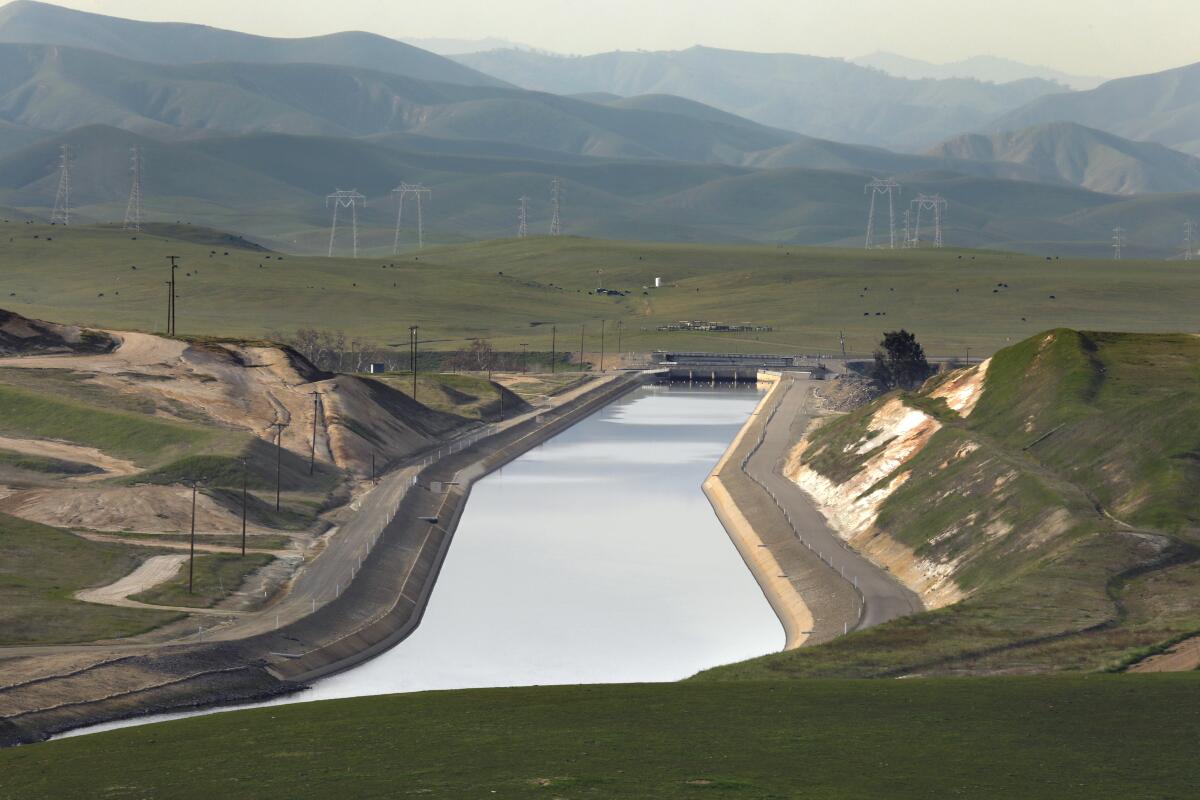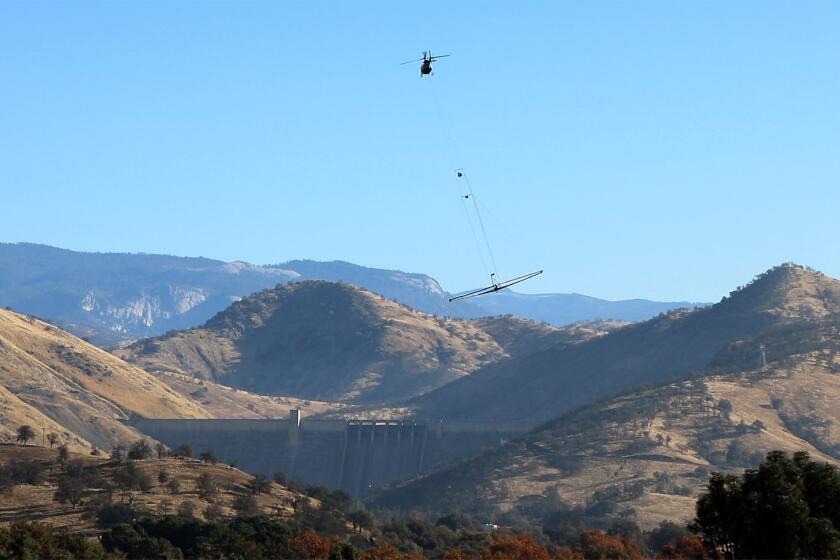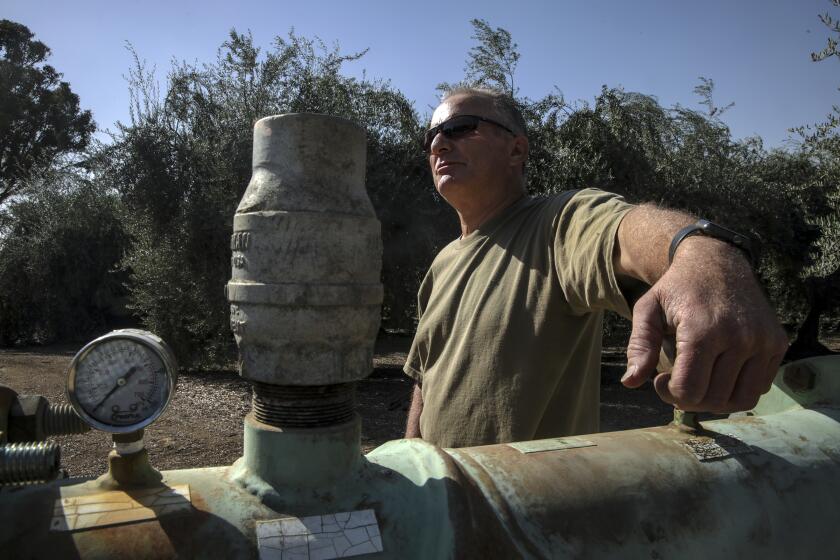Flush with rain, California plans to replenish drought-depleted groundwater with floodwaters

- Share via
With torrential rains drenching California, state water regulators have endorsed a plan to divert floodwaters from the San Joaquin River to replenish groundwater that has been depleted by heavy agricultural pumping during three years of record drought.
The State Water Resources Control Board approved a request by the U.S. Bureau of Reclamation to take more than 600,000 acre-feet from the river and send much of that water flowing to areas where it can spread out, soak into the ground and percolate down to the aquifer beneath the San Joaquin Valley.
The amount of water that’s set to be rerouted under the plan is more than the annual supply for the city of Los Angeles. Some of the water will also be routed to wildlife refuges along the San Joaquin River starting next week, officials said.
The plan is intended to address potential flood risks, capitalize on California’s near-record snowpack and capture some of the high flows from the latest extreme storms to store water underground.
“We are taking steps to maximize groundwater recharge in a way that the state of California has never really done before,” said Erik Ekdahl, deputy director of the State Water Board’s water rights division. “This is an immense opportunity to help recharge these depleted aquifers.”
In a new study, scientists begin to map underground channels that are optimal areas for recharging California’s groundwater in the Central Valley.
State officials said their order allows the Bureau of Reclamation to manage flood flows from Friant Dam and change points where water is diverted along the San Joaquin River.
Where water sinks into the ground and replenishes the aquifer, it could help address declines in water levels that have left families with dry wells in rural areas across the Central Valley. Stabilizing water levels could also help alleviate the widespread problem of collapsing ground triggered by overpumping, which has caused costly damage to canals and other infrastructure.
Gov. Gavin Newsom said after the three driest years in state history, “California is taking decisive action to capture and store water for when dry conditions return.”
Newsom has sought to prioritize capturing stormwater and recharging groundwater as central pieces of his administration’s strategy for adapting to more intense water extremes with climate change. On Friday, the governor’s office announced that he had signed an executive order enabling the capture of water from the latest round of storms.
The Bureau of Reclamation manages the dams, reservoirs and canals of the Central Valley Project and sends water to contractors including large agricultural irrigation districts and other agencies. The state order allows the federal government to deliver floodwater from the Mendota Pool, a small reservoir on the San Joaquin River, to be used for replenishing groundwater.
The water, which would otherwise have flowed down the San Joaquin River, will be available for irrigation districts and other agencies to divert for replenishing groundwater for more than four months. Under temporary contracts with the federal government, they will be able to send water through canals to areas with permeable soils that allow for groundwater recharge.
Some floodwaters will also pour into wildlife refuges, among them the San Luis National Wildlife Refuge, Mendota Wildlife Area and Los Banos Wildlife Area.
The State Water Board said in its order that the changes allow for capturing “high flows that would otherwise go unused,” easing pressures on flood-control infrastructure and helping to address chronic declines in groundwater levels.
Well-drilling and pumping continue to draw down groundwater in California’s Central Valley. Calls are growing for stronger legislation and state intervention.
Environmental groups including the Natural Resources Defense Council and the Bay Institute objected to the plan, saying in a letter that the water diversions would allow for lower flows in the San Joaquin River than called for under a 2006 legal settlement, and would likely be harmful for Chinook salmon.
“While the order does not completely dry up the San Joaquin River, it will divert most of the water that was supposed to flow down the river under the court-approved settlement agreement, primarily to benefit corporate agribusinesses in the Westlands Water District,” said Doug Obegi, a senior attorney with the Natural Resources Defense Council. “Yet again, agribusinesses win while the environment gets less than its fair share of water.”
Amanda Fencl, a senior climate scientist for the nonprofit Union of Concerned Scientists, said the plan raises questions about who will benefit the most, especially since many water contracts in the area are held by agricultural irrigation districts.
“It’s critical to recharge aquifers, especially when there’s an influx of rain,” Fencl said. “But there’s still an open question to me about whether other water users like households on domestic wells and community water systems will get to benefit.”
State officials disagreed with the objections raised by environmental groups, saying the water diversions won’t harm the environment and the flows left in the river will meet requirements.
“There’s still going to be a lot of water moving down the San Joaquin,” Ekdahl said. “The amount of water that will be rediverted here is still relatively low compared to how much water will be flowing in the system.”
The Newsom administration and the federal government drew criticism from environmental groups for another decision last month, when they petitioned the State Water Board to temporarily waive water-quality rules in the Sacramento-San Joaquin River Delta in an effort to store more water in reservoirs. The board ended that waiver on Thursday, saying the latest rains and snow make it no longer necessary.
Newsom set a goal last year, as part of his water supply plan, to increase average annual groundwater recharge by about 500,000 acre-feet. The State Water Board said that since December it has signed off on diverting about 790,000 acre-feet of water for groundwater replenishment as well as supplies for wildlife refuges.
Most of the water pumped from wells in the Central Valley supplies farms that produce a wide variety of crops, from almonds to tangerines.
Scientists found in a recent study that the depletion of groundwater in the valley has accelerated in recent years. They estimated that groundwater losses since 2003 have totaled about 36 million acre-feet, or about 1.3 times the full water-storing capacity of Lake Mead, the country’s largest reservoir.
Excessive groundwater pumping has long been depleting aquifers in California’s Central Valley. Now, scientists say the depletion is accelerating.
As state officials have increasingly prioritized aquifer recharge, they have pointed out that there is vast storage space available underground, and that replenishing groundwater is one of the simplest and most economical ways to take advantage of wet years.
Local water agencies have started to plan recharge projects as they begin to implement plans to curb excessive pumping, as required under the state’s 2014 Sustainable Groundwater Management Act.
There has also been a growing focus among water management officials on finding ways to ease the permit process to use storm water for aquifer recharge, and to invest strategically in infrastructure to move water to areas where permeable soils make for fast paths to the groundwater.
The State Water Board said the single request from the federal government cleared the way for large-scale recharge without the need for approving numerous smaller permits.
The water that’s used to replenish the aquifer will help local agencies move toward goals of addressing overpumping under the groundwater law, said Thomas Harter, a professor of water resources at UC Davis.
Harter said 600,000 acre-feet is “a significant chunk, and it’s certainly an important stepping stone toward future wet years and getting to these goals.” He said the water stored underground can allow for eventual cutbacks in well-water use to be somewhat less severe than the reductions would otherwise need to be.
“To the degree we can increase the supply, and we can only do that by capturing these large flood flows and storing them, that’s our main card in this game,” Harter said. “It’s not going to take away the need to reduce the demand, but it will lessen the need to do that.”
Ann Willis, California regional director for the group American Rivers, said she thinks the newly approved plan is a good approach to recharge severely depleted groundwater.
“It expedites the regulatory process to take advantage of these higher flows when they’re available,” Willis said. “This is a positive thing that we’re doing this, and I think we’re going to learn a lot from it.”
She said the minimum river flow required under the permit seems too low to support a healthy San Joaquin River, but flow gauges have recorded rising flows above that level.
“I think right now we have plenty of water to do both — both recharge and environmental flows,” Willis said. “But that isn’t always true. And we should be mindful about which one of those objectives we prioritize when there isn’t enough water to go around.”
While the state takes advantage of the storms to store water underground, efforts to rebuild depleted groundwater reserves will take time, said Karla Nemeth, director of the California Department of Water Resources. She said state officials are working with local agencies to expand these efforts and improve the permitting process for more recharge projects.
“We hope that over the course of these next series of storms, we can identify those projects and get those recharge systems activated,” Nemeth said. “We know drought conditions will return to California, and it’s really these moments that we have to capture, so that we can be resilient in the event of future dry conditions.”
Times staff writer Hayley Smith contributed to this report.










